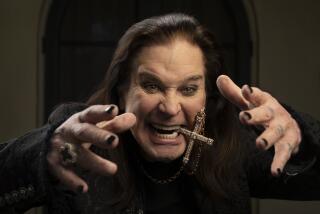Everybody has ... lost their minds
- Share via
WHEN the time comes to play “Crazy” during a Gnarls Barkley concert, the duo’s singer, Cee-Lo Green, introduces the song as “an instant classic.” He sounds as if he means it, and he just might be right. Rarely has a pop single seemed to permeate the culture’s audio environment the way “Crazy” did last spring and summer.
And that’s no illusion. “Crazy” was all but inescapable, a presence at most every kind of radio station there is. It reached the Top 10 on Billboard’s Hot 100, pop, modern rock, dance airplay, adult Top 40 and adult contemporary charts.
The song is a prominent nominee for record of the year at tonight’s Grammys, and Gnarls Barkley’s album “St. Elsewhere” is up for album of the year, capping a memorable rookie season for the odd-couple team of Atlanta rapper and soul singer Green and L.A.-based writer-producer Danger Mouse.
Tradition-rooted and creatively iconoclastic, the duo has a credibility and an experimental edge that’s helped bring “Crazy” the stamp of critical approval and the indefinable but undeniable glow of cool. Rolling Stone declared it the best single of 2006, and it was named the top track of the year in both the Village Voice’s and the Idolator blog’s polls of some 500 music critics.
So what is it about this concentrated (it comes and goes in less than three minutes), minor-key ministration that’s allowed it to cross so many lines?
“When we first heard it, we all looked at each other and went, ‘This is so unique. There’s nothing like this.... It’s going to be huge,’ ” says Lisa Worden, music director of L.A. rock radio station KROQ-FM (106.7), recalling the staff meeting where the song was presented. “We knew it would strike a chord with our listeners, and it did from the first spin.”
The record’s immediate appeal owes much to its use of iconic musical archetypes, starting with the Al Green R&B; feel that forms its taut core. Danger Mouse also adds a sample of spaghetti western strings (the Italian composers of the source material, a 1968 song called “Last Men Standing,” get a songwriting credit), and there’s a rock drive in there too.
The mix of gospel roots and cinematic drama suggests a merging of pulpit and padded cell, which is what you want when Cee-Lo’s high, powerful voice opens by singing, “I remember when I lost my mind.” Actually, he sings, “I remember when, I remember, I remember when
Green goes on to explore the fine line between the sane and the crazy. Some have read it as a metaphor for moving beyond the “craziness” of gang life. Others hear a language associated with addiction recovery. Green and Danger Mouse have said it was based on the idea that artists are popularly perceived as being crazy.
“It’s really a song about emotions,” says folk-pop singer Shawn Colvin, whose concert performance of the song was so well-received by fans that she released a sound-check recording of it online.
“It’s a unique overview and I related to it 100%,” she adds.
“I mean, I’ve been through some emotional lows that were otherworldly, and I’ve never heard it described so well, except for maybe just the title of ‘The Bell Jar’ by Sylvia Plath....
“That feeling of feeling crazy, but knowing you know too much -- I just thought that was brilliant,” Colvin says.
“There’s just a wisdom to it, and a down-to-earth-ness.... It’s a pleasure for me to sing every single one of those words.... It’s medicinal.”
More to Read
The biggest entertainment stories
Get our big stories about Hollywood, film, television, music, arts, culture and more right in your inbox as soon as they publish.
You may occasionally receive promotional content from the Los Angeles Times.










